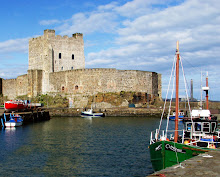
(Larger version: http://picasaweb.google.com/plummerspixels/PlummersPixels?authkey=Gv1sRgCO7Wpdygp6OvUA#5404859596594892370 )
On the evening of Sunday, April 2, 1911 Malcolm Andrews, his second wife Jane, and two of his unmarried daughters were at home in Braemar Street, Belfast. Georgina, his third unmarried daughter was visiting her married twin-sister Elizabeth Scott for the night. She is recorded on that family's census form. His other two married daughters Margaret Shanks and Mary Glencross are listed with their families under their married names. Those census forms tell more than who lived where that night almost 100 years ago. That census also records the jobs they held. John Malcolm Andrews' descendents were still tied to the linen industry in 1911. According to the form my grandmother Sarah was a linen weaver. Aunt Georgie was a damask weaver. Aunt Edie was a machinist (she was a "spoke stitcher"), and the majority of Aunt Mary's family also worked in the linen mills. That's not too surprising as almost ten percent of Belfast's population was engaged in the textile industry, people didn't venture too far from home and very, very few had the opportunity to advance from manual labor to a profession.
Those old census forms also show that some things don't change. Great grandfather Malcolm recorded his daughters' jobs simply as Weaver and Machinist. He also recorded that his wife was 62 years old. It took bureaucracy, in the form of Constable Robert Lynch to provide the additional information that Sarah was a linen weaver and Edith was a blouse machinist. And, I am sure that Constable Lynch received a frosty farewell from Great grandma Jane and a cold welcome thereafter when he changed her age from 62 to 65.

